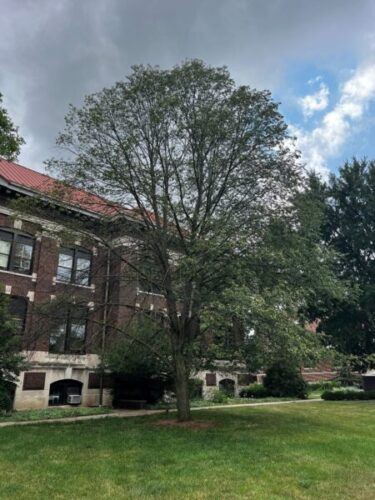 Purdue University - Extension - Forestry and Natural Resources
Purdue University - Extension - Forestry and Natural Resources
Got Nature? Blog
The Indiana Natural Resources Teacher Institute (NRTI) is an annual multi-day conservation education workshop and tour of forest management, forest industry and forestry research in Indiana. The purpose of the institute is to provide an introduction to the impact sustainable forestry has on our state’s environment, economy, and quality of life, and to equip teachers to apply that knowledge in the classroom.
The 5-day workshop advances effective teaching and learning about Indiana’s forest resources and their management. Participants will learn how to approach the teaching of STEM (science, technology, engineering and math) concepts and principles from a natural resource perspective through exposure to professionals, researchers, and industry leaders and hands-on experiences in the field. Participants develop a curriculum project to be implemented with their students, bringing natural resource science and management topics and activities into the classroom.

Natural Resources Teacher Institute participants discuss natural resource issues as part of a Project Learning Tree activity session.
Several partners and many sponsors and supporters facilitate this program. The Indiana DNR Division of Forestry Project Learning Tree Coordinator, Lexi Eiler, serves as the lead on this project, and the Division provides housing for the participants at the Morgan Monroe State Forest Training Center. Donna Rogler, the originator of the Indiana NRTI, Lenny Farlee, Purdue Forestry and Natural Resources Extension Forester, and Mary Cutler, Tippecanoe County Parks and Recreation Naturalist, serve as Instructors/facilitators with Lexi for the week of activities and tours. Each of these individuals is also an alumnus of Purdue Forestry and Natural Resources!
Presenters from several agencies, organizations, and companies assist with field tours and presentations, including a tour and activities on the Hardwood Ecosystem Experiment site at Morgan Monroe State Forest. The connection with this long-term, large-scale research project provides a unique STEM application teachers can take back to their classrooms.

Participants experience forest science, forest management, and forest products processing at the Natural Resources Teacher Institute.
The NRTI program can accommodate up to 16 teachers, with emphasis on primary educators, but welcoming to educators from all ages and backgrounds. Many past participants have called this week the best professional development training they have attended. Some comments from our most recent class in June of 2024:
“It was amazing. I am grateful for the activities and all the fantastic materials provided.”
“I learned so much about forestry and forest ecology. I can’t wait to share my lesson with the students.”
“Loved my time at the Indiana Natural Resources Teacher Institute! I learned so much and can’t wait to share and do activities at school this year.”
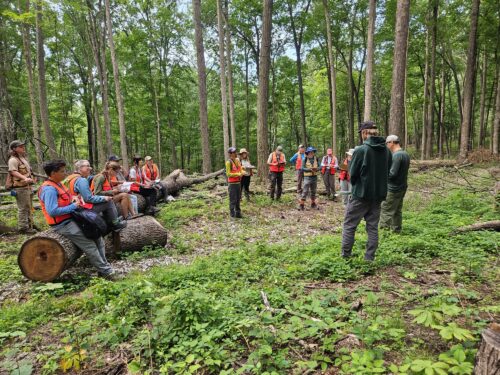
Teachers meet with Indiana DNR foresters to learn about forest management techniques on state forests.
Educators interested in the workshop can visit this DNR website to find out more about schedules and applications – https://www.in.gov/dnr/forestry/programs/education/
Resources:
Purdue Forestry and Natural Resources Facebook Page
Project Learning Tree
Indiana Department of Natural Resources Division of Forestry
The Nature of Teaching, Purdue Department of Forestry and Natural Resources
The Nature of Teaching: Trees of the Midwest, The Education Store
The Nature of Teaching: Adaptations for Aquatic Amphibians, The Education Store
Trees of the Midwest Webinar, Nature of Teaching YouTube channel
Indiana Forestry Educational Foundation, Indiana Forestry & Woodland Owners Association
Forest/Timber, Playlist, Purdue Extension – Forestry and Natural Resources YouTube Channel
Natural Resources Teacher Institute Takes Forestry to the Classroom, Purdue FNR News
Purdue Extension
Donna Rogler, Coordinator
Indiana Project Learning Tree
Lenny Farlee, Sustaining Hardwood Extension Specialist
Purdue University Department of Forestry and Natural Resources
How does forest management affect wildlife, specifically birds? Which birds prefer which types of forest habitat? How can you help birds thrive on your property?
The Forestry for the Birds Virtual Tour is a new tool developed by Purdue Forestry and Natural Resources and Purdue Extension, which offers answers to those questions and more in an easily digestible and visual format. The virtual tour is based on The Nature Conservancy’s Forestry for the Birds program.
The virtual tour is an interactive guide to forest management techniques and birds in the forest that features 360-degree images, including several taken on eight Purdue FNR properties across the state. Bird identification resources from Cornell Lab of Ornithology’s Macaulay Library, forest management resources from Purdue Extension and more make the tour come to life and allow landowners to improve their identification and management skillsets.
The tour was created and is narrated by Kaitlyn Young, a 2022 wildlife alumna and current FNR master’s degree student. Young spent the summer of 2023 monitoring birds as an avian monitoring and extension intern for the Purdue FNR Extension Internship program.
Young conducted breeding bird surveys and made recordings of all the species she encountered whether audibly or visually last summer. She utilized a GoPro Max to capture 360-degree images of the properties she surveyed. Song Meter Mini acoustic monitors allowed her to capture various bird songs, which are incorporated into the background of some of the virtual scenes of the tour. Still camera images also provide stunning visuals of each property and bird type.
“I think my favorite thing about the tour is that when you are exploring each scene, it really feels like you are there,” Young explains. “I want folks who may not be able to visit our properties to feel like they are right there, inside the scene, while learning a thing or two about bird conservation and managing our forests for our rapidly declining feathery friends.”
Young is quick to note, however, that it is much easier to spot the birds she added to each scene of the tour than when trying to look for them during surveys, when they are often hiding behind the leaves in the canopy.
Forestry for the Birds is a project developed by the Indiana Chapter of The Nature Conservancy, which provides foresters and private landowners with the information and tools needed to enhance their forests in a way that fosters thriving bird communities. Many resources, including the Forestry for the Birds pocket guides, focus on the “Birders’ Dozen,” or 12 bird species which nest in the Central Hardwood ecoregion of Indiana that are easy to identify by sight and/or sound, and need conservation action to assist with range-wide or local population declines. The Birders’ Dozen species were selected by The Nature Conservancy and an independent group of birders, ornithologists and conservationists.
The virtual tour focuses on how different forest stewardship practices and forest types can benefit a variety of bird species, including the Birders’ Dozen. In each scene, there are three or more bird species to look for, recorded bird songs which are representative of what you could hear in that scene, interactive icons that link to images and videos and an audio description of the scene.
“I’m excited to see this virtual tour come to fruition – it provides some depth of information to complement the Forestry for the Birds Pocket Guide and Silvicultural Guide,” said Jessica Outcalt, Purdue Extension Educator, who helped develop the Forestry for the Birds materials for TNC. “I especially appreciate the visuals and audio that can’t be communicated via printed materials, and how this tour captures the sense of being in a forest that will make the material accessible to a wider audience.”
The properties shown illustrate a variety of forest stewardship techniques ranging from single tree selection to group tree selection, shelterwood, clearcut, oak woodland restoration and prescribed fire. The tour also highlights both young forests and mature closed-canopy forests.
The Birders’ Dozen includes:
- Yellow-billed and Black-billed Cuckoo
- Eastern Whip-poor-will
- American Woodcock
- Eastern Screech-Owl
- Red-headed Woodpecker
- Wood Thrush
- Eastern Towhee
- Yellow-Breasted Chat
- Baltimore Oriole
- Worm-eating Warbler
- Hooded Warbler
- Cerulean Warbler
*Bird species listed above with links will take you to the Indiana Woodland Steward website as they share highlights with this information in “The Birders’ Dozen Profile” written by Jessica Outcalt.
The American Woodcock, Wood Thrush and Cerulean Warbler are listed on the National Audubon Society watchlist, while the Cerulean warbler is state endangered in Indiana. The Eastern Whip-poor-will, American Woodcock, Worm-eating Warbler and Hooded Warbler have been noted as species of special concern by the Indiana Department of Natural Resources Division of Fish and Wildlife.
To view this article along with other news and stories posted on the Purdue Forestry and Natural Resources website view: Virtual Tour Brings Forest Management for the Birds to Life.
Resources:
Breeding Birds and Forest Management: the Hardwood Ecosystem Experiment and the Central Hardwoods Region, The Education Store, Purdue Extension – Forestry and Natural Resources
Forest Birds, The Education Store
Managing Woodlands for Birds, The Education Store
Managing Woodlands for Birds Video, Purdue Extension-Forestry and Natural Resources (FNR) YouTube Channel
Breeding Birds and Forest Management: the Hardwood Ecosystem Experiment and the Central Hardwoods Region, The Education Store
The Birders’ Dozen, Profile: Baltimore Oriole, Indiana Woodland Steward
Ask An Expert, Playlist, Purdue Extension – FNR YouTube channel
It’s For the Birds, Indiana Yard and Garden-Purdue Consumer Horticulture
Birds and Residential Window Strikes: Tips for Prevention, The Education Store, Purdue Extension resource center
No Room at the Inn: Suburban Backyards and Migratory Birds, Education Store, Purdue Extension resource center
Putting a Little Wildlife in Your Backyard This Spring, The Education Store
Wendy Mayer, FNR Communications Coordinator
Purdue University Department of Forestry and Natural Resources
Purdue Landscape Report: With recent rain storms across the state, watering may not be at the forefront of everyone’s minds. But as we head deeper into summer it is food to remember most of Indiana is in a state of abnormal dryness to moderate drought, continuing similar conditions from previous years. With that in mind, we should be thinking about the health of our trees (Fig. 1).
Understanding what drought is and its effects on trees can help to bolster care plans. Drought is an extended time with little to no precipitation and can slow growth, reducing photosynthesis, and depleting energy reserves trees need to survive dormancy in winter. Drought conditions can stress trees, making them susceptible to pests and diseases, reducing their ability to produce defensive chemicals, and in severe situations resulting in death (Fig. 2).
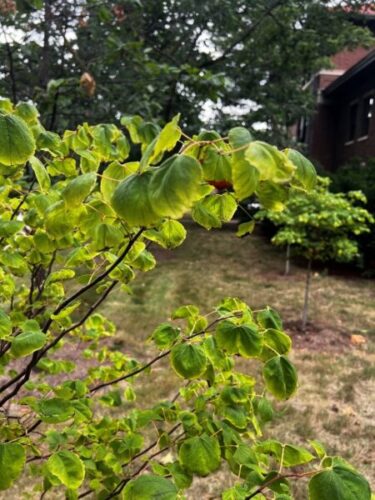
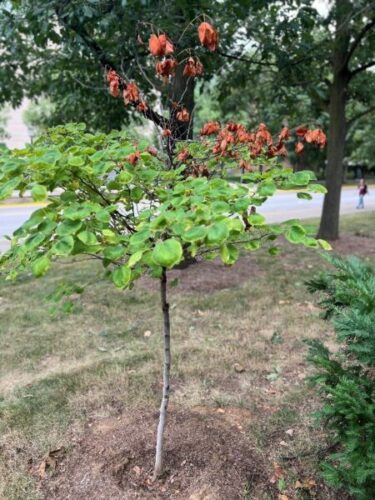
One simple task to protect your trees is watering. This is especially important in young and newly transplanted trees. A good industry guideline is the 5-plus-5 rule. Apply 5 gallons of water plus 5 gallons for every diameter inch of the trunk. For example, a 4-inch tree would require about 25 gallons of water as needed. A good tactic to reduce water runoff from the hose is to take a large bucket and drill enough small holes to create a slow drip watering system. Also check moisture levels in your soil to see if conditions are dry, moist, or saturated.
Another way to maintain soil moisture is to mulch around the tree. Mulch rings should be at least 3 feet in diameter and 2-3 inches deep with a 2–3-inch space between the base of the trunk and the inner mulch ring. Mulching up to the trunk is called volcano mulching and causes issues like stem girdling root production and decay. Mulching reduces evaporation from the soil and helps maintain moderate soil temperatures. It also reduces competition with surrounding lawn and landscaping plants while protecting the trunk from mechanical damage caused by mowing and lawn care practices.
These little steps can go a long way to protect your trees, extending their life spans and your enjoyment with a healthy canopy. For a more detailed look at drought and trees, please have a look at the Purdue extension store here.
Original article posted: Summer Tree Care: Watering Your Trees.
Subscribe and receive the newsletter: Purdue Landscape Report Newsletter.
Resources:
Planting Your Tree Part 1: Choosing Your Tree, Purdue Extension YouTube Channel
Tree Planting Part 2: Planting a Tree, Purdue Extension YouTube Channel
Tree Installation: Process and Practices, The Education Store
Tree Pruning Essentials, The Education Store
Tree Pruning Essentials Video, Purdue Extension YouTube Channel
Drought Information, Indiana Department of Natural Resources
Drought? Don’t forget the trees!, The Education Store
Tree Defect Identification, The Education Store
Tree Wound and Healing, Got Nature? Blog, Purdue Extension – Forestry and Natural Resources
Surface Root Syndrome, The Education Store
Find an Arborist video, Trees are Good-International Society of Arboriculture (ISA)
Trees and Storms – The Education Store, Purdue Education’s resource center
Indiana Invasive Species Council
ID That Tree, Playlist, Purdue Extension – FNR YouTube Channel (Invasive White Mulberry, Siberian Elm, Tree of Heaven)
Fifty Common Trees of Indiana
An Introduction to Trees of Indiana
Native Trees of the Midwest, The Education Store
Subscribe – Purdue Extension-FNR YouTube Channel
Ben McCallister, Urban Forestry Specialist
Purdue Forestry & Natural Resources
In this webinar, hosted by Indiana Forestry & Woodland Owners Association, Joe Caudell, state deer biologist with Indiana DNR Division of Fish and Wildlife, shares recent efforts to better understand Indiana deer populations and how they vary across the landscape. The research from the Integrated Deer Management Project, a multi-year research project with Purdue Forestry and Natural Resources team working closely with the DNR biologists, created research management units (RMUs) so that they could be easily incorporated into deer management practices by the DNR.
Additional resources:
- Indiana Hunt for Hunger Program, Indiana Department of Natural Resources (IN DNR).
- If you’re interested in learning more about Indiana’s white tailed deer hunting and management, see the IN DNR page. There is a section on deer management with deer reports, survey results, and real time harvest data: White-Tailed Deer Hunting.
- Integrated Deer Management Project Website Introduced, Purdue College of Agriculture News.
- DNR Adopts RMU Research Techniques Created by Integrated Deer Management Project, Purdue College of Agriculture News.
- Deer Exclosures, Integrated Deer Management Project, Video, Purdue Extension – Forestry and Natural Resources (FNR) YouTube Channel
Check out the Indiana Forestry & Woodland Association YouTube Channel for videos including: What is IFWOA?; A New Carbon Program for Hardwood Landowners Webinar, Indiana’s Native Orchids, Magnificent Trees of Indiana, Be Tick Aware and much more.
The Indiana Forestry & Woodland Owners Association (IFWOA) was founded in 1977 and is a non-profit organization dedicated to conservation and sustainable management of woodlands in Indiana. IFWOA advocates for scientific best practices for management to achieve objectives of clean water, wildlife habitat, soil protection, native species diversity, timber production, recreation, carbon sequestration and many others.
IFWOA is an affiliate of the National Woodland Owners Association. IFWOA is a partner, collaborator or is represented on leading National and State organizations. These memberships or collaborations are selected to advance Indiana Woodland owner’s interests. IFWOA monitors and influences legislation and economic trends impacting Indiana woodlands and landowners for our members. Membership in IFWOA provides a valuable network linkage to information and resources at the leading edge of science, industry and politics impacting Indiana woodlands.
More Resources:
Ask an Expert, Playlist, Purdue Extension – FNR YouTube Channel
Wildlife Habitat Hint: Trail Camera Tips and Tricks, Video, Purdue Extension – FNR YouTube channel
Wildlife Habitat Hint, Playlist
Trail camera survey for white-tailed deer, Got Nature? Blog
Handling Harvested Game: Episode 1, Field Dressing, Video
Woodland Stewardship for Landowners: Managing Deer Damage to Young Trees, Purdue Extension-FNR YouTube Channel
Managing Your Woods for White-Tailed Deer, The Education Store, Purdue Extension’s resource center
Introduction to White-tailed Deer Impacts on Indiana Woodlands, Got Nature? Blog & The Education Store
Liz Jackson, Engagement Lead
Indiana Forestry & Woodland Association
In this edition of ID That Tree, Purdue Extension forester Lenny Farlee takes us through the different characteristics of coniferous trees found here in Indiana, particularly their foliage and the features that pertain to them. Come along as we look through real examples of shape, scales, leaf and branches of various local trees. The featured species include Eastern red cedarwood, Northern white cedar, and more.
If you have any questions regarding wildlife, trees, forest management, wood products, natural resource planning or other natural resource topics, feel free to contact us by using our Ask an Expert web page.
Resources:
ID That Tree: Firs and Spruces, Video Playlist, Purdue Extension – Forestry and Natural Resources (FNR) YouTube Channel
ID That Tree – Jack Pine, Scotch Pine, Red Pine, Virginia Pine, Eastern White Pine, Video Playlist, Purdue Extension – Forestry and Natural Resources (FNR) YouTube Channel
Beat Back Borers Attacking Pines and Other Cone Bearing Trees, Purdue Landscape Report
Tree Diseases: White Pine Decline in Indiana, The Education Store, Purdue Extension Resource Center
Purdue Arboretum Explorer
Conservation Tree Planting: Steps to Success, Purdue Extension – FNR YouTube Channel
A Woodland Management Moment, Playlist, Purdue Extension – FNR YouTube Channel
Woodland Stewardship for Landowners, Playlist, Purdue Extension – FNR YouTube Channel
Indiana Department of Natural Resources: Invasive Species
Indiana Invasive Species Council
Cooperative Invasive Species Management Area (CISMA)
Report Invasive, Purdue Extension
Episode 11 – Exploring the challenges of Invasive Species, Habitat University-Natural Resource University
Shrubs and Woody Vines of Indiana and the Midwest, The Education Store
Native Trees of the Midwest, The Education Store
Professional Forester, Indiana Forestry Woodland Owners Association
Forest Improvement Handbook, The Education Store
Find an Arborist, International Society of Arboriculture
Lenny Farlee, Extension Forester
Hardwood Tree Improvement and Regeneration Center
Purdue Department of Forestry & Natural Resources
In this edition of ID That Tree, Purdue Extension forester Lenny Farlee goes over leaf characteristics to look for when attempting to identify broadleaved deciduous trees in Indiana. He shares the features of both single and compound leaves while outlining the differences between tree leaves. He takes you through a thorough guide on analyzing the leaflets, leaves, stems and buds, while increasing your knowledge of your surroundings.
If you have any questions regarding wildlife, trees, forest management, wood products, natural resource planning or other natural resource topics, feel free to contact us by using our Ask an Expert web page.
Resources:
ID That Tree – Jack Pine, Scotch Pine, Red Pine, Virginia Pine, Eastern White Pine, Video Playlist, Purdue Extension – Forestry and Natural Resources (FNR) YouTube Channel
Beat Back Borers Attacking Pines and Other Cone Bearing Trees, Purdue Landscape Report
Tree Diseases: White Pine Decline in Indiana, The Education Store, Purdue Extension Resource Center
Purdue Arboretum Explorer
Conservation Tree Planting: Steps to Success, Purdue Extension – FNR YouTube Channel
A Woodland Management Moment, Playlist, Purdue Extension – FNR YouTube Channel
Woodland Stewardship for Landowners, Playlist, Purdue Extension – FNR YouTube Channel
Indiana Department of Natural Resources: Invasive Species
Indiana Invasive Species Council
Cooperative Invasive Species Management Area (CISMA)
Report Invasive, Purdue Extension
Episode 11 – Exploring the challenges of Invasive Species, Habitat University-Natural Resource University
Shrubs and Woody Vines of Indiana and the Midwest, The Education Store
Native Trees of the Midwest, The Education Store
Professional Forester, Indiana Forestry Woodland Owners Association
Forest Improvement Handbook, The Education Store
Lenny Farlee, Extension Forester
Hardwood Tree Improvement and Regeneration Center
Purdue Department of Forestry & Natural Resources
In this episode of A Woodland Management Moment, Purdue Extension forester Lenny Farlee talks about the importance of oak regeneration. Oak is a ‘keystone’ species, integral to supporting many different facets of wildlife. This includes insects to large mammals all across the environment in Indiana and the central hardwood region. This video also shares details regarding Purdue’s initiatives to ensure the diverse ecosystems maintained by oak and to provide the resources needed to keep regenerating this integral tree
If you have any questions regarding trees, forests, wildlife, wood products or other natural resource topics, feel free to contact us by using our Ask an Expert web page.
Resources:
A Woodland Management Moment, Playlist, Purdue Extension – Forestry and Natural Resources (FNR) YouTube Channel
Learn How to Support Oak-Hickory Ecosystems, Purdue Extension – FNR Got Nature? Blog
The Nature of Oaks Webinar, Purdue Extension-FNR YouTube Channel, Shared from Indiana Forestry & Woodland Owners Association
Oak Leaf Tatters, Purdue Landscape Report
Inonotus Dryadeus, Butt and Root Rot of Oaks, Purdue Extension – FNR Got Nature? Blog
Predicting the Height Growth of Oak Species Reproduction Over a 23-year Period Following Clearcutting, Hardwood Tree Improvement & Regeneration Center (HTIRC)
Conservation Tree Planting: Steps to Success, Purdue Extension – FNR YouTube Channel
Shrubs and Woody Vines of Indiana and the Midwest, The Education Store, Purdue Extension Resource Center
Native Trees of the Midwest, The Education Store
ID That Tree, Playlist, Purdue Extension – FNR YouTube Channel
Investing in Indiana Woodlands, The Education Store
Woodland Stewardship for Landowners Video Series, Playlist, Indiana Department of Natural Resources YouTube Channel
Ask an Expert: Tree Selection and Planting, Purdue Extension – FNR YouTube Channel
Forest Improvement Handbook, The Education Store
Find an Indiana Professional Forester, Indiana Forestry & Woodland Owners Association (IFWOA)
Purdue Arboretum Explorer
Lenny Farlee, Extension Forester
Hardwood Tree Improvement and Regeneration Center
Purdue Department of Forestry & Natural Resources
The long lifespan of many trees, which could be centuries or even millennia in the case of a few species, is a source of awe and inspiration for many. The bark of trees can often tell some stories about their life and history, if we know how to interpret what we see. Here are a few examples you may run across in Indiana.
Is this tree sick? That may be a natural question to ask when looking at the striking difference in the bark pattern on this white oak. In fact, it is an infection, but not a harmful one to the survival of the tree. This is called smooth patch and is caused by a fungus that infects the outer bark of oak and some other tree species. There are several species of fungus that may cause this appearance, but the most common is Aleurodiscus oaksii. The fungus gradually decomposes the outer layers of bark, producing the flattened and smooth surfaces which contrast with the rough bark that is uninfected. If you look closely during moist periods, you may see the small cup-shaped fruiting bodies of the fungus on the bark. It is not a threat to the health or integrity of the tree as only the outer bark is impacted.
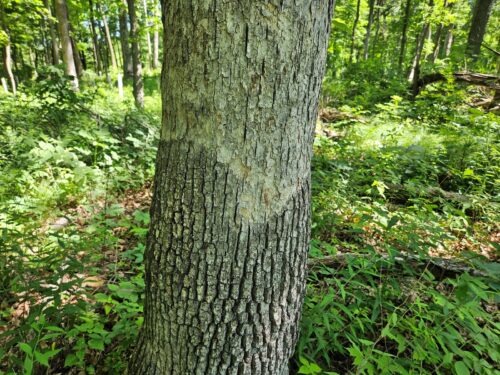

This isn’t the same species of tree, is it? Yes, it is! Bark pattern differences in some species may reflect the growth rate or relative vigor of the tree. These photos show black walnut bark from two very different growing sites. The blocky, alligator-hide bark pattern is often an indication of slow growth and may result from a tree growing on a very difficult site, like the dry hilltop where this tree is located, or severe competition from surrounding trees. The strongly interlacing ridges of the bark in the second photo are from a black walnut growing in a plantation on a creek bench with deep, moist and fertile soils, resulting in more vigorous growth.
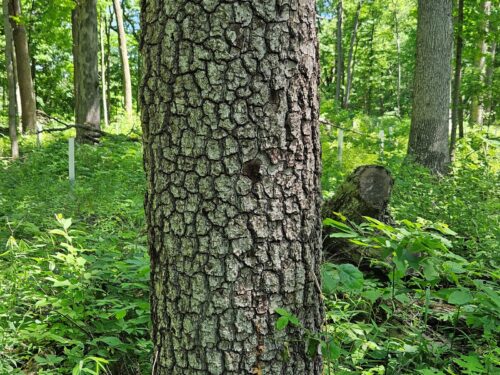
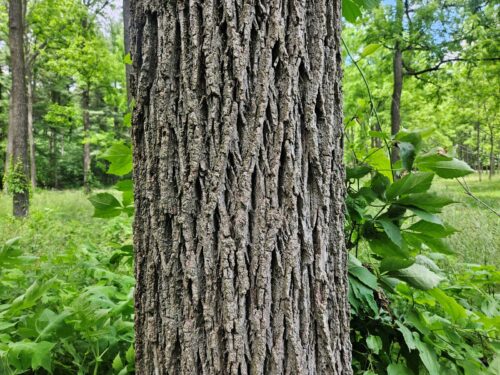
What happened here? The pattern in a horizontal line across these trees looks too perfect to be natural, but it was not produced by a human. This is the feeding activity of the yellow-bellied sapsucker, a species of woodpecker that migrates through Indiana. The sapsucker, true to its name, uses its sharp bill to create holes through the bark that ooze sap. The sapsucker feeds on the sap and may also feed on insects drawn to the sap. They tend to create straight lines of holes that leave this diagnostic pattern behind, even long after the birds have ceased their activity. This activity is usually not fatal to the tree, but does cause some damage to the wood beneath the bark, so trees that have been used by sapsuckers may have discolored spots or other blemishes in the wood revealed when processed for wood products. To see images and learn more about sapsuckers visit American Bird Conservatory Website.

Humans also may leave a history of our presence on trees. This American beech tree in a recreation area has recorded the comings and goings of visitors, with some apparent editing as well! I do not endorse this activity as it can be harmful to the tree by introducing avenues for decay and disease, and is generally prohibited on public property. Instead, enjoy reading the nature stories found in bark.
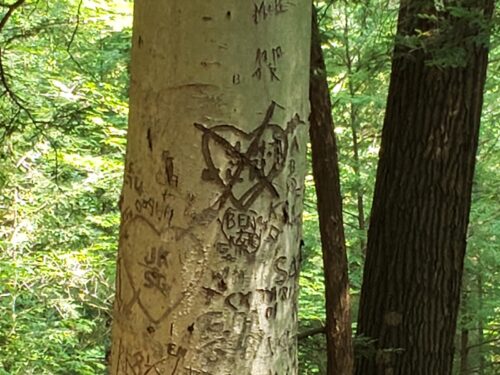
Resources:
Hardwoods of the Central Midwest, Purdue Arboretum Explorer
Forest Improvement Handbook, The Education Store, Purdue Extension’s resource center
ID That Tree, Purdue Extension-Forestry & Natural Resources (FNR) YouTube playlist
Native Trees of the Midwest, The Education Store
Woodland Management Moment , Purdue Extension-FNR YouTube playlist
Tree Installation: Process and Practices, The Education Store, Purdue Extension’s resource center
Planting Your Tree Part 1: Choosing Your Tree, video, The Education Store
Tree Risk Management – The Education Store
Find an Arborist website, Trees are Good, International Society of Arboriculture (ISA)
Subscribe Purdue Extension-Forestry and Natural Resources YouTube Channel
Lenny Farlee, Extension Forester
Hardwood Tree Improvement and Regeneration Center
Purdue Department of Forestry & Natural Resources
Familiar with surprise lilies? Indiana has a native surprise onion!
Many yards where I grew up in southern Indiana were graced with surprise lilies. These plants grew long narrow leaves in the spring, which faded and died by early summer. After a pause with no evidence of the plant, long stems with pink lily-like flowers emerged, with no leaves to be seen.

Ramps foliage is often found in clusters or patches in early spring. These leaves will die before summer.
While these plants are not a native species, we do have a native with similar habits that is a distant relative of the surprise lily. That plant is ramps, also known as wild leek and a variety of other local names. There are two species of ramps recognized now – the more common broad-leaved ramps, Allium tricoccum, and the narrow-leaved ramps, Allium burdickii. Ramps are related to onions and garlic and have odor and taste reminiscent of those plants. Ramps foliage emerges early in the spring and was one of the earliest green edibles available to First Nations people and early European settlers.
Many communities developed festivals or celebrations centered on the emergence of ramps as a sign of spring and some fresh greens to eat. The bright green leaves emerge before the tree leaves and fade before summer, but by the first half of June expect to see thin stems with a rounded cluster of small white flowers emerge – our surprise onion! It may take a ramps plant seven to ten years from seed to produce a flower, so this is a slow-growing and long-lived forest perennial. The flowers are pollinated by insects and produce round black seeds that may stay on the stalk through winter.
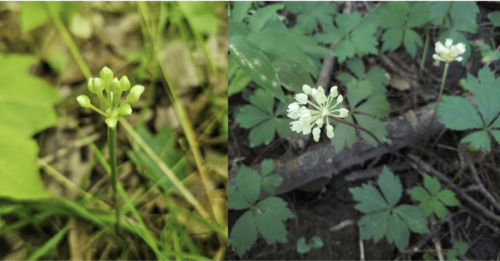
Newly emerged flower stem and buds and the blooming flowers of ramps.
Look for ramps in well-shaded forest areas with moist soils. They have a scattered distribution across Indiana, so you won’t find them in every woodland. The leaves and bulbs are edible, but absolute certainty of ID is essential as there are some toxic plants that look similar. Check ID references and spend some time with experienced foragers before eating any wild plants. The onion/garlic odor of ramps is a good indicator for positive ID.
Since this is a slow growing plant with a limited distribution, over-collection is a threat. A responsible harvesting technique is to harvest one leaf from mature plants, leaving the other leaves and the bulb. If you harvest the whole plant, take less than 5 percent of the plants in a patch, allowing seeding and bulb division to repopulate the area. Seed or bulbs can also be used to plant new patches. So keep you eyes open for our local surprise flowers this June – ramps!
Resources:
ID That Tree, Playlist, Purdue Extension – Forestry and Natural Resources (FNR) YouTube Channel
A Woodland Management Moment, Playlist, Purdue Extension – FNR YouTube Channel (Against Invasives, Garlic Mustard, Autumn Olive)
Woodland Stewardship for Landowners, Playlist, Purdue Extension – FNR YouTube Channel (Common Buckthorn, Japanese Barberry)
Indiana Department of Natural Resources: Invasive Species
Indiana Invasive Species Council
Cooperative Invasive Species Management Area (CISMA)
Episode 11 – Exploring the challenges of Invasive Species, Habitat University-Natural Resource University
What are invasive species and why should I care?, Got Nature? Blog, Purdue Extension – FNR
Shrubs and Woody Vines of Indiana and the Midwest, The Education Store, Purdue Extension Resource Center
Planting Your Tree Part 1: Choosing Your Tree, video, The Education Store
Find an Arborist website, Trees are Good, International Society of Arboriculture (ISA
Lenny Farlee, Extension Forester
Hardwood Tree Improvement and Regeneration Center
Purdue Department of Forestry & Natural Resources
In recognition of Pollinator Week 2024, let’s see what is blooming at Purdue FNR Tippecanoe County property, Martell Forest.
 Wild petunia, Ruellia sp, are several species found in woodland and sunny edge habitats. The blooms do look like the familiar garden petunia, but it is a different genus of plants. I caught small insects inside the flower, evidence of its pollinator value, although I have read the individual flowers may only last one day.
Wild petunia, Ruellia sp, are several species found in woodland and sunny edge habitats. The blooms do look like the familiar garden petunia, but it is a different genus of plants. I caught small insects inside the flower, evidence of its pollinator value, although I have read the individual flowers may only last one day.
 I came upon a unique parasitic plant that does not have chlorophyll or true leaves, but obtains its nutrients by parasitizing oak trees. This is American cancer root, Conopholis americana, also called bear corn, because of the similarity of the plant structure to an ear of corn. Although it lacks chlorophyll, it does possess flowers that propagate the plant.
I came upon a unique parasitic plant that does not have chlorophyll or true leaves, but obtains its nutrients by parasitizing oak trees. This is American cancer root, Conopholis americana, also called bear corn, because of the similarity of the plant structure to an ear of corn. Although it lacks chlorophyll, it does possess flowers that propagate the plant.
 Not far from the cancer root I found fire pink, Silene virginica. This is one flower that would be hard to miss! This is about as red as any native flower encountered in Indiana forests. If you are wondering why pink is in the name instead of red, it is a member of the pink family of plants, which include carnations and a rare prairie relative, royal catchfly. An effort was made a few years ago to make this our state flower, but that has not been acted upon so far.
Not far from the cancer root I found fire pink, Silene virginica. This is one flower that would be hard to miss! This is about as red as any native flower encountered in Indiana forests. If you are wondering why pink is in the name instead of red, it is a member of the pink family of plants, which include carnations and a rare prairie relative, royal catchfly. An effort was made a few years ago to make this our state flower, but that has not been acted upon so far.
 As I headed downhill I came across Virginia spiderwort, Tradescantia virginiana, with beautiful three-petaled violet to blue flowers clustered at the top of the plant. The flowers typically last only a day, but are rapidly replaced by the numerous buds below the current blooms.
As I headed downhill I came across Virginia spiderwort, Tradescantia virginiana, with beautiful three-petaled violet to blue flowers clustered at the top of the plant. The flowers typically last only a day, but are rapidly replaced by the numerous buds below the current blooms.
 Blue-eyed grass, Sisyrinchium sp. was encountered in a grassy area near a tree plantation. This is not a grass but several species that are members of the iris family. The tiny blooms and narrow leaves blend into the grass background.
Blue-eyed grass, Sisyrinchium sp. was encountered in a grassy area near a tree plantation. This is not a grass but several species that are members of the iris family. The tiny blooms and narrow leaves blend into the grass background.
 Some woody plants are blooming in June as well. This is the bell-shaped flower of American persimmon, Diospyros virginiana. Persimmon trees tend to bear either all male or all female flowers on a single tree, but occasionally a tree will have both. Female flowers are solitary on the stems while male flowers tend to be in small clusters.
Some woody plants are blooming in June as well. This is the bell-shaped flower of American persimmon, Diospyros virginiana. Persimmon trees tend to bear either all male or all female flowers on a single tree, but occasionally a tree will have both. Female flowers are solitary on the stems while male flowers tend to be in small clusters.
 The final bloom I have included is rough-leaved dogwood, Cornus drummondii, a shrub relative of the flowering dogwood that provides a white blossom show earlier in the spring. As the name implies, this shrub has leaves with a slightly sandpaper-texture and clusters of small white flowers that are attractive to many pollinators. This blooms later than several other dogwoods, extending the flowering season.
The final bloom I have included is rough-leaved dogwood, Cornus drummondii, a shrub relative of the flowering dogwood that provides a white blossom show earlier in the spring. As the name implies, this shrub has leaves with a slightly sandpaper-texture and clusters of small white flowers that are attractive to many pollinators. This blooms later than several other dogwoods, extending the flowering season.
More about Pollinator Week: this an annual celebration in support of pollinator health that was initiated and is managed by Pollinator Partnership. It is a time to raise awareness for pollinators and spread the word about what we can do to protect them. Pollinators include bees, butterflies, beetles, moths, wasps, hummingbirds, bats, flies, beetles, lizards, rodents and more.
Resources:
USDA Recognizes National Pollinator Week, U.S. Department of Agriculture
Ask an Expert: What’s Buzzing or Not Buzzing About Pollinators, Purdue Extension – Forestry & Natural Resources (FNR) YouTube Channel
Indiana Monarch and Pollinator Conservation website
Protecting Pollinators: Protecting Pollinators in Home Lawns and Landscapes, publication, The Education Store, Purdue Extension’s resource center
Consider Pollinators When Planning Your Garden, Got Nature? Blog, Purdue Extension – FNR
Pollinator Conservation Education, Purdue Entomology
Recommended Indiana-native Plants for Attracting Pollinators (pdf), Purdue Extension – Entomology
Attract Hummingbirds to Your Yard video, Purdue Extension – FNR YouTube Channel
Protecting Pollinators: Biology and Control of Varroa Mites in Bee Hives, The Education Store, Purdue Extension resource center
Gardening for Pollinators, Purdue Garden Articles
Subscribe Purdue Extension-Forestry and Natural Resources YouTube Channel
Lenny Farlee, Extension Forester
Hardwood Tree Improvement and Regeneration Center
Purdue Department of Forestry & Natural Resources
Recent Posts
- From Forest to Classroom – 2024 NRTI Class
Posted: July 26, 2024 in Community Development, Forestry, Urban Forestry, Wildlife - Virtual Tour Brings Forest Management for Birds to Life
Posted: July 19, 2024 in Forestry, How To, Publication, Wildlife - Summer Tree Care – Purdue Landscape Report
Posted: July 16, 2024 in Forestry, Forests and Street Trees, How To, Plants, Urban Forestry - DNR State Deer Biologist Shares Population Ecology of Deer-IFWOA Webinar
Posted: July 12, 2024 in Forestry, Wildlife, Woodlands - ID That Tree: Learn to Identify Conifer Leaf Types
Posted: July 11, 2024 in Forestry, Forests and Street Trees, How To, Urban Forestry, Wildlife - ID That Tree: Types of Broadleaved Tree Leaves
Posted: July 10, 2024 in Forestry, Forests and Street Trees, How To, Plants, Wildlife - Woodland Management Moment: Oak Regeneration – Protecting Seedlings
Posted: June 24, 2024 in Forestry, Urban Forestry, Wildlife, Woodland Management Moment, Woodlands - Stories in the Bark – Patterns and Growth
Posted: June 22, 2024 in Forestry, Forests and Street Trees, Wildlife, Woodlands - Indiana’s Surprise Onion Plants Emerge
Posted: June 20, 2024 in Forestry, Forests and Street Trees, Plants, Urban Forestry, Wildlife, Woodlands - Celebrate Pollinator Week With Flowers of June Tour
Posted: in Forestry, Gardening, Wildlife
Archives
Categories
- Alert
- Aquaculture/Fish
- Aquatic/Aquaculture Resources
- Ask the Expert
- Christmas Trees
- Community Development
- Disease
- Drought
- Forestry
- Forests and Street Trees
- Gardening
- Got Nature for Kids
- Great Lakes
- How To
- Invasive Animal Species
- Invasive Insects
- Invasive Plant Species
- Land Use
- Natural Resource Planning
- Nature of Teaching
- Plants
- Podcasts
- Ponds
- Publication
- Safety
- Spiders
- Timber Marketing
- Uncategorized
- Urban Forestry
- Webinar
- Wildlife
- Wood Products/Manufacturing
- Woodland Management Moment
- Woodlands

